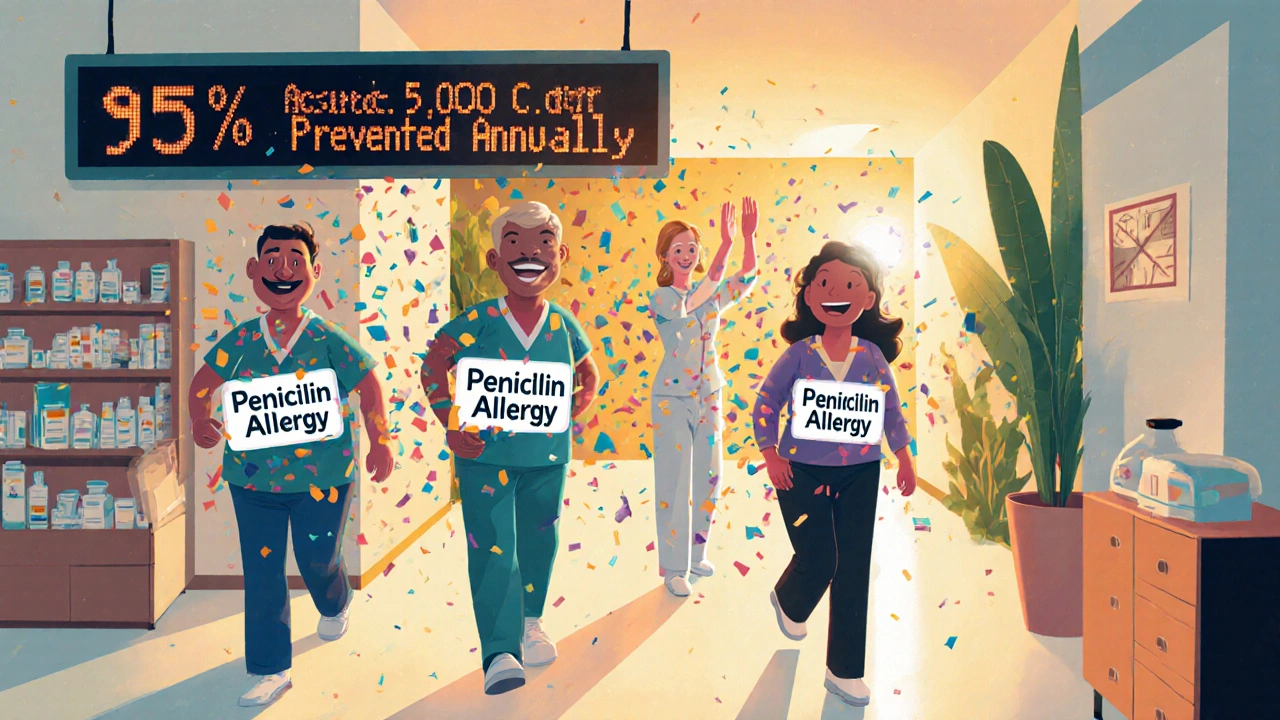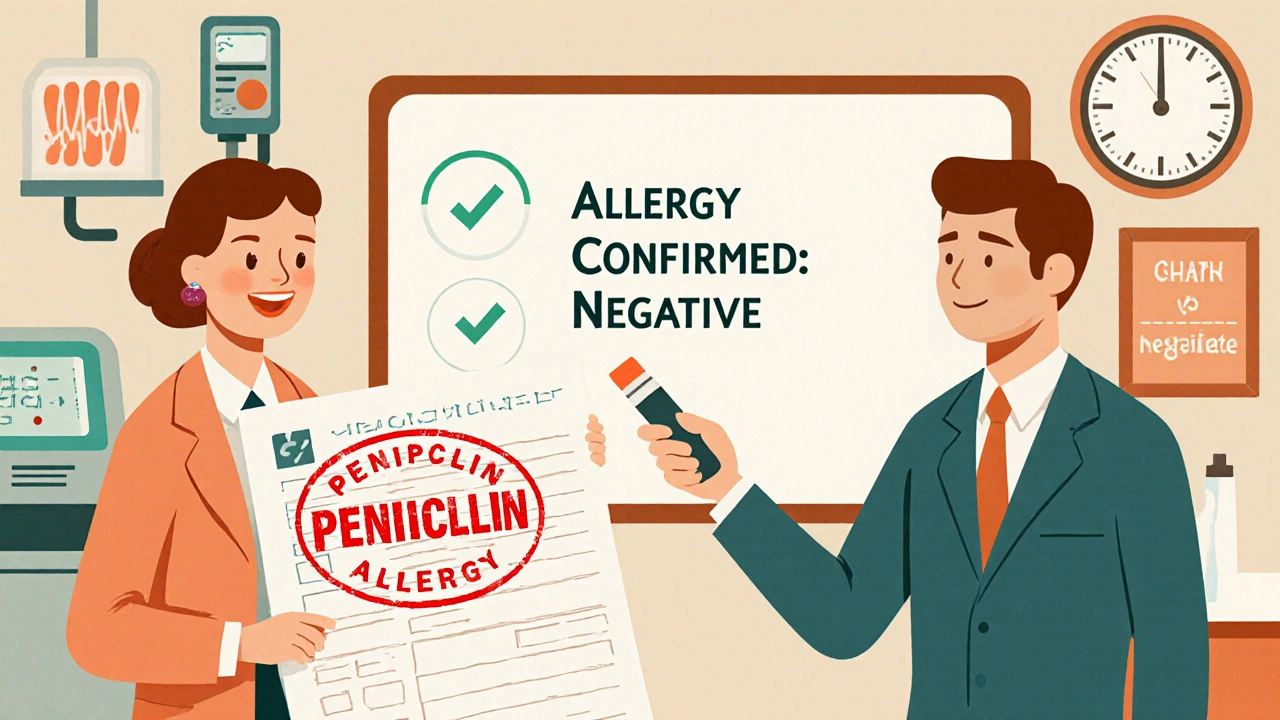More than 10% of people in the U.S. say they’re allergic to penicillin. But here’s the truth: 90 to 95% of them aren’t. That’s not a guess. It’s what multiple studies, including data from the CDC and the Infectious Diseases Society of America, have confirmed over the last decade. If you’ve been told you’re allergic to penicillin - maybe because you got a rash as a kid, or your mom said you were allergic - you might be avoiding a safe, cheap, and highly effective antibiotic for no reason. And that’s putting your health at greater risk than the allergy itself.
Why Penicillin Allergy Labels Are Dangerous
When someone is labeled as penicillin-allergic, doctors don’t just avoid penicillin. They avoid the entire class of beta-lactam antibiotics - including amoxicillin, ampicillin, and even some cephalosporins. That’s because the label sticks, even if the original reaction was mild, vague, or happened decades ago. But the alternatives aren’t better. Instead of penicillin, patients get drugs like clindamycin, vancomycin, or fluoroquinolones. These are broader-spectrum antibiotics. They kill more types of bacteria - including the good ones. That’s why patients with a penicillin allergy label are:- 69% more likely to get a Clostridioides difficile infection (C. diff), a dangerous gut infection that causes severe diarrhea and can be life-threatening
- 50% more likely to develop surgical site infections after operations
- 30% more likely to have treatment fail - meaning the infection doesn’t go away, and they end up back in the hospital
And it’s not just about health. The cost difference is huge. A course of amoxicillin costs around $35. The alternatives? Often over $95. For hospitals, that adds up to millions in extra spending every year. For patients, it means higher bills, longer stays, and more complications.
What Penicillin Allergy Testing Actually Is
Penicillin allergy testing isn’t a blood test. It’s not a questionnaire. It’s a two-step clinical process designed to find out if your body truly reacts to penicillin with an IgE-mediated response - the kind that causes hives, swelling, or anaphylaxis. The first step is skin testing. A tiny amount of penicillin derivative (called Pre-Pen, or penicilloyl-polylysine) is placed on the skin, then gently pricked. If nothing happens, a small amount is injected just under the skin (intradermal). This is repeated with minor determinant reagents, which catch reactions that the main component might miss. The whole process takes about an hour. If the skin test is negative, the next step is an oral challenge. You’re given a small dose of amoxicillin - usually 250 mg - and watched for at least one hour. If you don’t react, you’re cleared. No more allergy label. No more risky antibiotics. This isn’t experimental. It’s been used since the 1960s. Studies show it’s over 95% accurate at ruling out true IgE-mediated allergies. That means if you pass both tests, your risk of a future severe reaction is the same as someone who never said they were allergic.
Who Should Get Tested - and Who Shouldn’t
Not everyone needs testing. The key is knowing your history. Low-risk patients can often skip skin testing entirely and go straight to an oral challenge. These include people who:- Had a rash more than 72 hours after taking penicillin
- Only had nausea, headache, or dizziness
- Had a reaction more than 10 years ago
- Were told they were allergic by a parent or family member, but never saw a doctor
- Stevens-Johnson syndrome
- Toxic epidermal necrolysis
- DRESS syndrome (drug rash with eosinophilia and systemic symptoms)
- Severe liver or kidney injury from a drug
These are delayed, T-cell mediated reactions. They’re not IgE-based, so skin testing won’t help. And you must avoid all beta-lactams for life.
Why Testing Isn’t Available Everywhere - Yet
You’d think a simple, proven test that saves money and lives would be everywhere. But it’s not. As of 2022, only 44% of U.S. hospitals had access to an allergist who could perform skin testing. Just 39% offered inpatient testing. That’s because the procedure requires trained staff, specific reagents, and time - things many hospitals don’t prioritize. But things are changing. Since 2017, the CDC has pushed hospitals to integrate penicillin allergy testing into their antibiotic stewardship programs. By 2023, 68% of large hospitals had formal de-labeling protocols - up from just 22% in 2018. Pharmacists and nurses are now being trained to run assessments and oral challenges in many hospitals. In academic medical centers, pharmacists perform nearly half of all penicillin allergy evaluations - up from 12% in 2017. The biggest barrier isn’t science. It’s workflow. Doctors don’t always ask about allergy history. Nurses don’t always flag old labels. Electronic records don’t always prompt providers to re-evaluate.
The Future: Faster, Simpler, More Accessible
A new, all-in-one skin test kit is currently under FDA review. It combines the major determinant (Pre-Pen), minor determinants, and amoxicillin - all in one vial. Early results from a 2022 study of 455 patients showed a 98% negative predictive value. That means if you test negative, you’re almost certainly safe. No oral challenge needed. Meanwhile, three top medical centers - Mayo Clinic, Johns Hopkins, and UCSF - are piloting rapid testing protocols. These can be done in under 30 minutes by non-allergist providers, using streamlined steps and trained staff. Preliminary accuracy? 96.5%. The CDC predicts that by 2027, 85% of U.S. hospitals will have routine penicillin allergy testing built into their systems. If that happens, we could prevent 50,000 to 70,000 cases of C. diff every year - and save billions in healthcare costs.What You Can Do Right Now
If you’ve been told you’re allergic to penicillin:- Look at your medical record. Is the allergy listed as “penicillin allergy” with no details? That’s a red flag.
- Ask yourself: What happened? When? Was it a rash? Swelling? Vomiting? Did you get treated for it?
- Ask your doctor: “Can I be tested to see if I’m still allergic?”
- If you’re in the hospital, ask your pharmacist. They’re often the first to push for de-labeling.
- If you’ve never taken penicillin since the reaction - you’re likely safe to try it again, under supervision.
Don’t assume the label is true. Don’t assume it’s permanent. And don’t assume avoiding penicillin is safer. The data says otherwise.
Penicillin is one of the most studied drugs in history. It’s effective, affordable, and generally safe. If you’re avoiding it because of an old label, you’re not protecting yourself - you’re putting yourself at higher risk.
Testing isn’t just about allergies. It’s about better care. Better outcomes. Lower costs. And it’s available - if you know to ask for it.
Can you outgrow a penicillin allergy?
Yes, most people do. Studies show that 80% of people who had a penicillin allergy as children lose the sensitivity within 10 years - even if they never took the drug again. That’s why labeling someone for life based on a childhood rash is outdated. Testing is the only way to know if the allergy is still real.
Is penicillin allergy testing painful?
It’s not. Skin testing feels like a tiny pinch, similar to a blood sugar test. Some people feel mild itching at the test site if they’re reacting, but serious reactions during testing are extremely rare - especially when done by trained staff. The oral challenge uses a low dose of amoxicillin and is closely monitored. Most people feel nothing at all.
Can I be tested if I’m pregnant?
Yes. Penicillin is the first-line treatment for syphilis during pregnancy, and avoiding it puts both mother and baby at risk. The CDC updated its guidelines in 2023 to confirm that 97% of pregnant women with a penicillin allergy label can safely receive penicillin after testing. Skin testing and oral challenges are considered safe in all trimesters.
What if the test is positive?
If you have a positive skin test, you still have options. Many non-penicillin antibiotics are effective. In some cases, desensitization - a controlled process of slowly introducing the drug under close supervision - can be done if penicillin is absolutely necessary. But for most people, avoiding penicillin is the safest path if testing confirms a true allergy.
Can I get tested if I’ve never taken penicillin?
Not usually. Testing is only recommended for people with a history of a suspected reaction. If you’ve never taken penicillin and have no symptoms, there’s no reason to test. The label only matters if you’ve had a reaction before - and even then, it might be wrong.


Write a comment